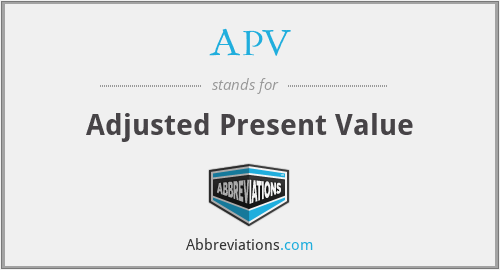What does APV mean in Unclassified?
This page is about the meanings of the acronym/abbreviation/shorthand APV in the Miscellaneous field in general and in the Unclassified terminology in particular.
Adjusted Present Value
Translation
Find a translation for Adjusted Present Value in other languages:
Select another language:
- - Select -
- 简体中文 (Chinese - Simplified)
- 繁體中文 (Chinese - Traditional)
- Español (Spanish)
- Esperanto (Esperanto)
- 日本語 (Japanese)
- Português (Portuguese)
- Deutsch (German)
- العربية (Arabic)
- Français (French)
- Русский (Russian)
- ಕನ್ನಡ (Kannada)
- 한국어 (Korean)
- עברית (Hebrew)
- Gaeilge (Irish)
- Українська (Ukrainian)
- اردو (Urdu)
- Magyar (Hungarian)
- मानक हिन्दी (Hindi)
- Indonesia (Indonesian)
- Italiano (Italian)
- தமிழ் (Tamil)
- Türkçe (Turkish)
- తెలుగు (Telugu)
- ภาษาไทย (Thai)
- Tiếng Việt (Vietnamese)
- Čeština (Czech)
- Polski (Polish)
- Bahasa Indonesia (Indonesian)
- Românește (Romanian)
- Nederlands (Dutch)
- Ελληνικά (Greek)
- Latinum (Latin)
- Svenska (Swedish)
- Dansk (Danish)
- Suomi (Finnish)
- فارسی (Persian)
- ייִדיש (Yiddish)
- հայերեն (Armenian)
- Norsk (Norwegian)
- English (English)
Definition
What does APV mean?
- Adjusted present value
- Adjusted present value (APV) is a valuation method introduced in 1974 by Stewart Myers. The idea is to value the project as if it were all equity financed ("unleveraged"), and to then add the present value of the tax shield of debt – and other side effects. See Leverage (finance). Technically, an APV valuation model looks similar to a standard DCF model. However, instead of WACC, cash flows would be discounted at the unlevered cost of equity, and tax shields at either the cost of debt (Myers) or following later academics also with the unlevered cost of equity. See Hamada's equation. APV and the standard DCF approaches should give the identical result if the capital structure remains stable. According to Myers, the value of the levered firm (Value levered, Vl) is equal to the value of the firm with no debt (Value unlevered, Vu) plus the present value of the tax savings due to the tax deductibility of interest payments, the so-called value of the tax shield (VTS). Myers proposes calculating the VTS by discounting the tax savings at the cost of debt (Kd). The argument is that the risk of the tax saving arising from the use of debt is the same as the risk of the debt. As mentioned, the method is to calculate the NPV of the project as if it is all-equity financed (so called "base case"). Then the base-case NPV is adjusted for the benefits of financing. Usually, the main benefit is a tax shield resulted from tax deductibility of interest payments. Another benefit can be a subsidized borrowing at sub-market rates. The APV method is especially effective when a leveraged buyout case is considered since the company is loaded with an extreme amount of debt, so the tax shield is substantial.
Popularity rank by frequency of use
How popular is APV among other acronyms?
APV#1#5465#12977
Embed
Citation
Use the citation below to add this abbreviation to your bibliography:
Style:MLAChicagoAPA
"APV." Abbreviations.com. STANDS4 LLC, 2024. Web. 16 Apr. 2024. <https://www.abbreviations.com/term/1452457>.



Discuss this APV abbreviation with the community:
Report Comment
We're doing our best to make sure our content is useful, accurate and safe.
If by any chance you spot an inappropriate comment while navigating through our website please use this form to let us know, and we'll take care of it shortly.
Attachment
You need to be logged in to favorite.
Log In